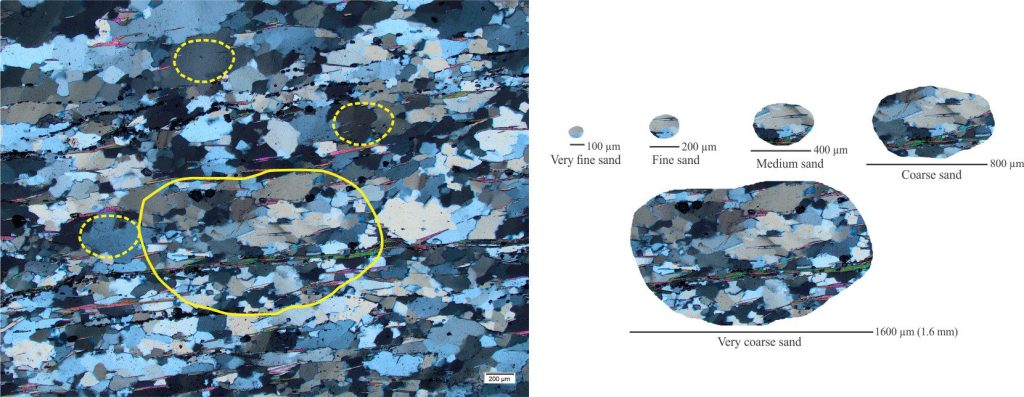
The utility of lithic grains as provenance indicators
The composition of terrigenous sandstone is usually described in terms of the tripartite quartz-feldspar-lithic framework. The quartz and feldspar clast end-members are monomineralic. The lithic end-member takes care of all other grain types that are a mix of minerals such as quartz, feldspar, clay, heavy minerals, volcanic groundmass, and carbonate.
Notwithstanding the value of zircon systematics to unravel potential sources of clastic sediment, most sandstone provenance studies begin with an evaluation of the granular framework. Unfortunately, the value of the common rock-forming minerals quartz and feldspar as provenance indicators is frequently ambiguous – a grain of monocrystalline quartz may be derived from granitic, rhyolitic, or gneissic source rocks; and polycrystalline quartz from several kinds of metamorphic rock, recrystallized sedimentary chert, or tectonized quartz-rich rocks. In comparison, a decent lithic is worth its weight in gold.
However, there are a couple of limitations that influence the value of lithic fragments as source rock indicators:
- The potential for diagenetic alteration of some components, particularly clay, feldspar, ferromagnesian minerals, and volcanic glass, and
- Grain size will influence the identifiability of source rock composition, texture, fabric, and structural attributes. As a general rule, larger clast sizes will afford greater confidence in interpretation.
The exercise below shows how the identification and interpretation of lithic clasts can change according to:
- The crystallinity or coarseness of the original source rock.
- The final grain size of lithic fragments.
Green schist
The first example is a quartz-rich green schist (Fox Glacier, New Zealand):
- Foliation is defined by biotite laths and elongation of quartz crystals.
- Mica crystal orientations are parallel from one foliation to the next.
- Quartz crystals have irregular, interlocking contacts.
- Quartz crystal size ranges from <100 μm to 600 μm (0.6 mm), corresponding to very fine through coarse sand size.
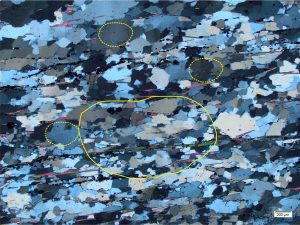
In the next image, hypothetical sand grains are ‘eroded’ from the green schist, beginning with the very coarse sand-sized fragment that, in turn, is whittled progressively to finer grain sizes (grain sizes are based on the Wentworth Scale).
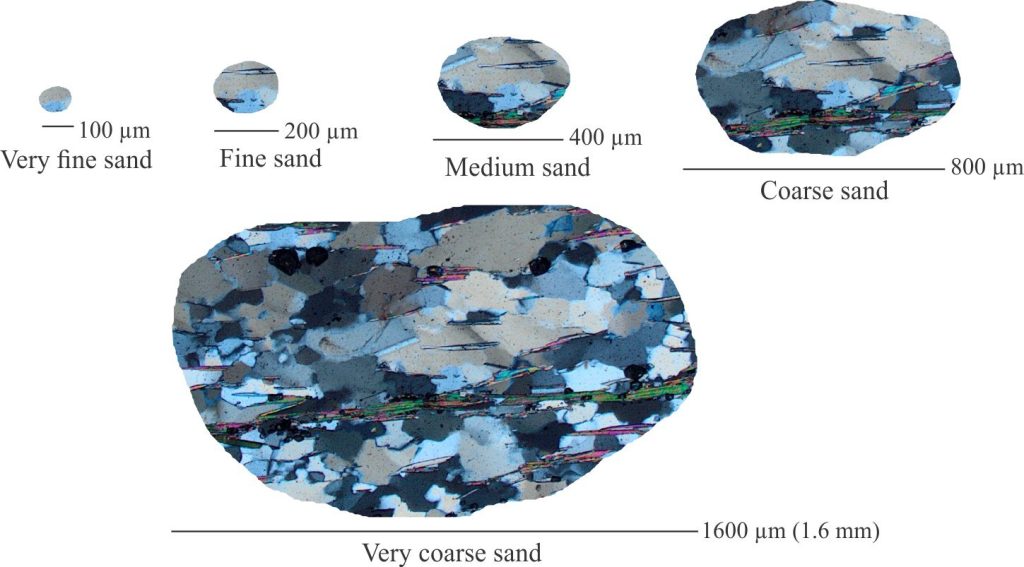
- Very coarse to coarse sand; The full complement of interlocking quartz grains, biotite laths and schistose foliation is recognizable in both grain sizes.
- Medium sand; quartz aggregates would probably be counted as polycrystalline quartz rather than lithic grains. Biotite may persist in medium sand-sized grains but its orientation at this scale of observation may not reflect the larger-scale foliation. Furthermore, the identification of foliation in quartz is also ambiguous.
- Fine to very fine sand; In this example, fine and very fine grain sizes have the same dimensions as many individual quartz crystals. In this case, quartz grains might be counted as monocrystalline or polycrystalline quartz rather than as lithics.
Biotite-hornblende gneiss
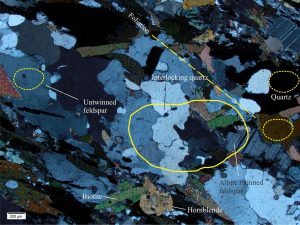
Gneissic rocks tend to be more coarsely crystalline than schist. In this example and at this scale (field of view is 3.8 mm wide), the foliation is recognizable but less distinct than in the green schist shown above. Biotite crystals are larger than their green schist counterparts and oriented at more variable angles to the foliation.
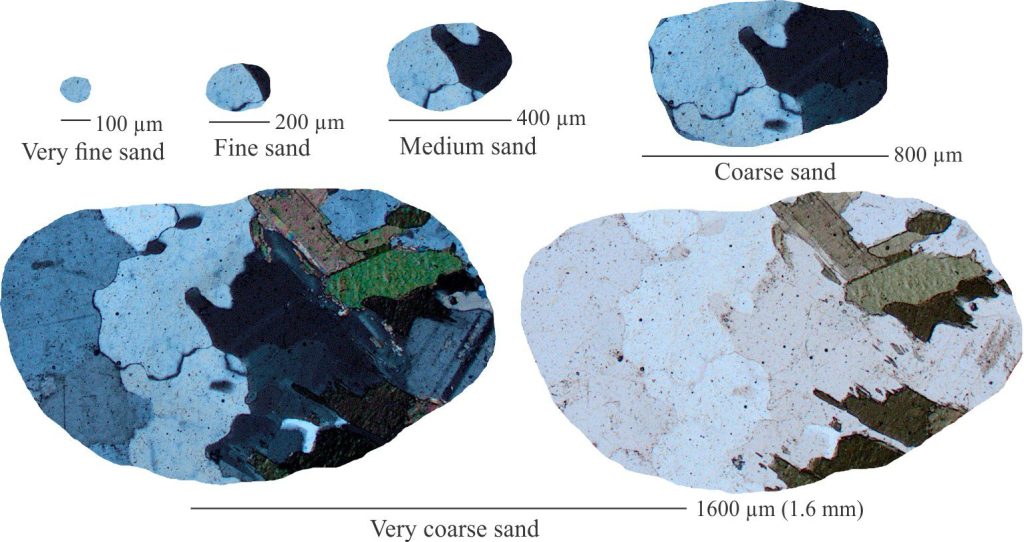
- Very coarse sand; This grain size captures large, untwinned feldspar, quartz, plagioclase (albite twinning), and a couple of biotite laths. However, the likelihood of capturing the gneissic foliation is low, even in very coarse-grained clasts.
- Coarse-grained and finer sand; Foliation is not identifiable in these grains.Medium sized grains may capture crystal a boundary, but many would appear monomineralic and difficult to differentiate from other sedimentary, volcanic, and intrusive source rocks.
- If grains at very coarse sand or larger are not available, then the distinction between this gneiss and possible granite, granodiorite, or reworked sedimentary source rocks will be ambiguous.
Biotite granite
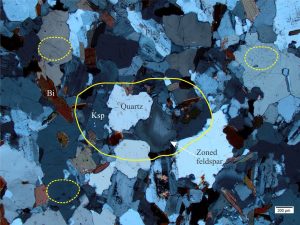
The granite consists of untwinned potassium feldspar, quartz, plagioclase, and biotite. Crystal sizes range from 100 μm to more than 1500 μm (1.5 mm), averaging 400-600 μm. There is no foliation. There is little evidence of strain in the quartz crystals.
The following diagram shows the progressive change in grain size and identifiable features that would lead to an interpretation of granite source rock.
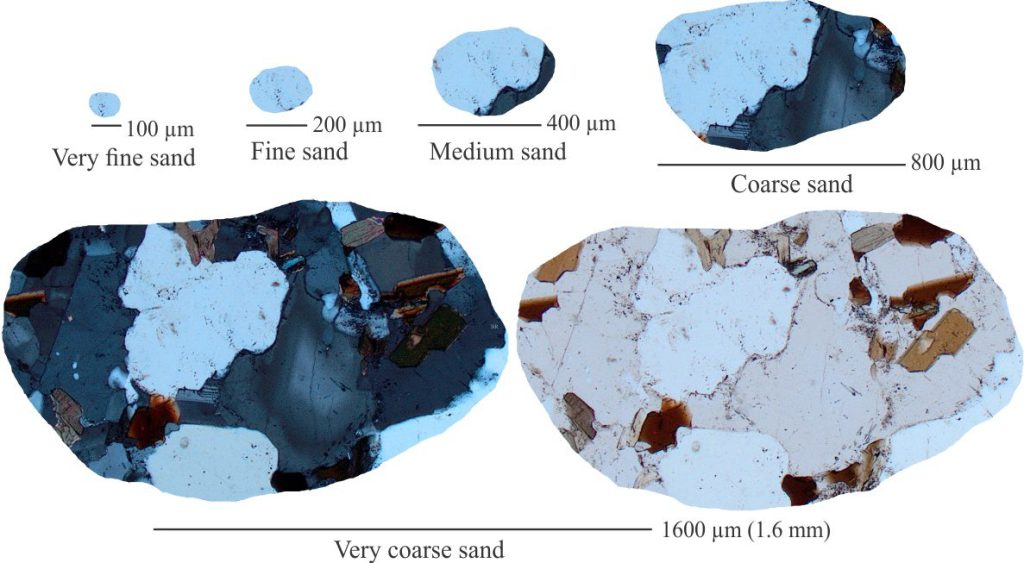
- Very coarse sand; Grains having this dimension have captured the essential feldspar-quartz-biotite aggregates. However, even at this grain size there may be difficulty distinguishing granite from some gneissic rocks, particularly if quartz shows any strained extinction.
- Coarse sand; This grain size may capture single crystals of quartz, feldspar or ferromagnesian minerals, in which case they may not be distinguishable from gneiss, acid volcanic, or reworked coarse-grained arenites. This ambiguity will persist even if crystal aggregate boundaries are preserved.
- Medium to very fine sand; Most grains will be counted as monomineralic. There will be little diagnostic information in these grains to distinguish them from many other source rock compositions.
Olivine basalt
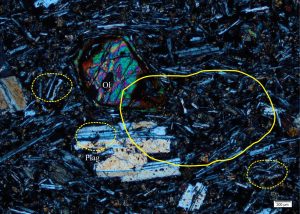
Like many basalts and andesites, this example contains centimetre-scale phenocrysts surrounded by a sea of very small plagioclase laths in much finer-grained groundmass (glass or altered glass). Volcanic textures like this are very distinctive and the corresponding lithic fragments are perhaps the most easily recognizable of all lithic types.
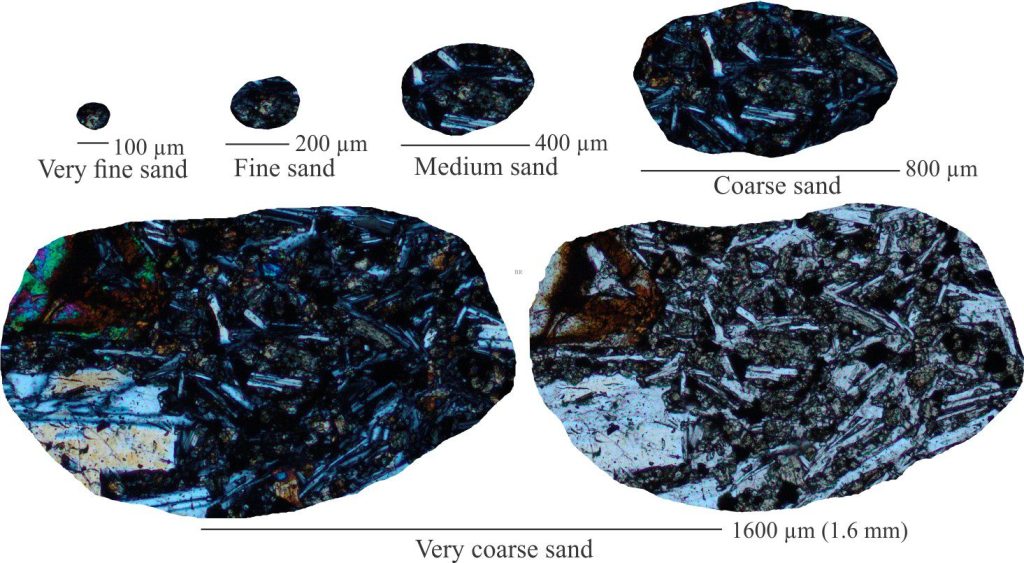
- Sand-sized clasts consisting of volcanic material are some of the more easily recognizable lithic grains, particularly if they contain groundmass.
- Very coarse to coarse sand; Phenocrysts may be captured in the coarsest size fraction, but commonly will tend to separate from the groundmass during weathering and erosion.
- Coarse sand and finer; Volcanic groundmass is characteristically glassy or altered glass that is anisotropic under crossed polars. Groundmass commonly contains a mass of very small plagioclase crystals; crystals may show some alignment (a product of original flow banding). These fabrics are common in basaltic and andesites rocks, and serve to distinguish them from mudrock lithic grains, even at fine sand size.
- Diagenetic alteration of the groundmass may render some lithics indistinguishable from siltstone – mudstone sourced lithic grains.
Recrystallized chert
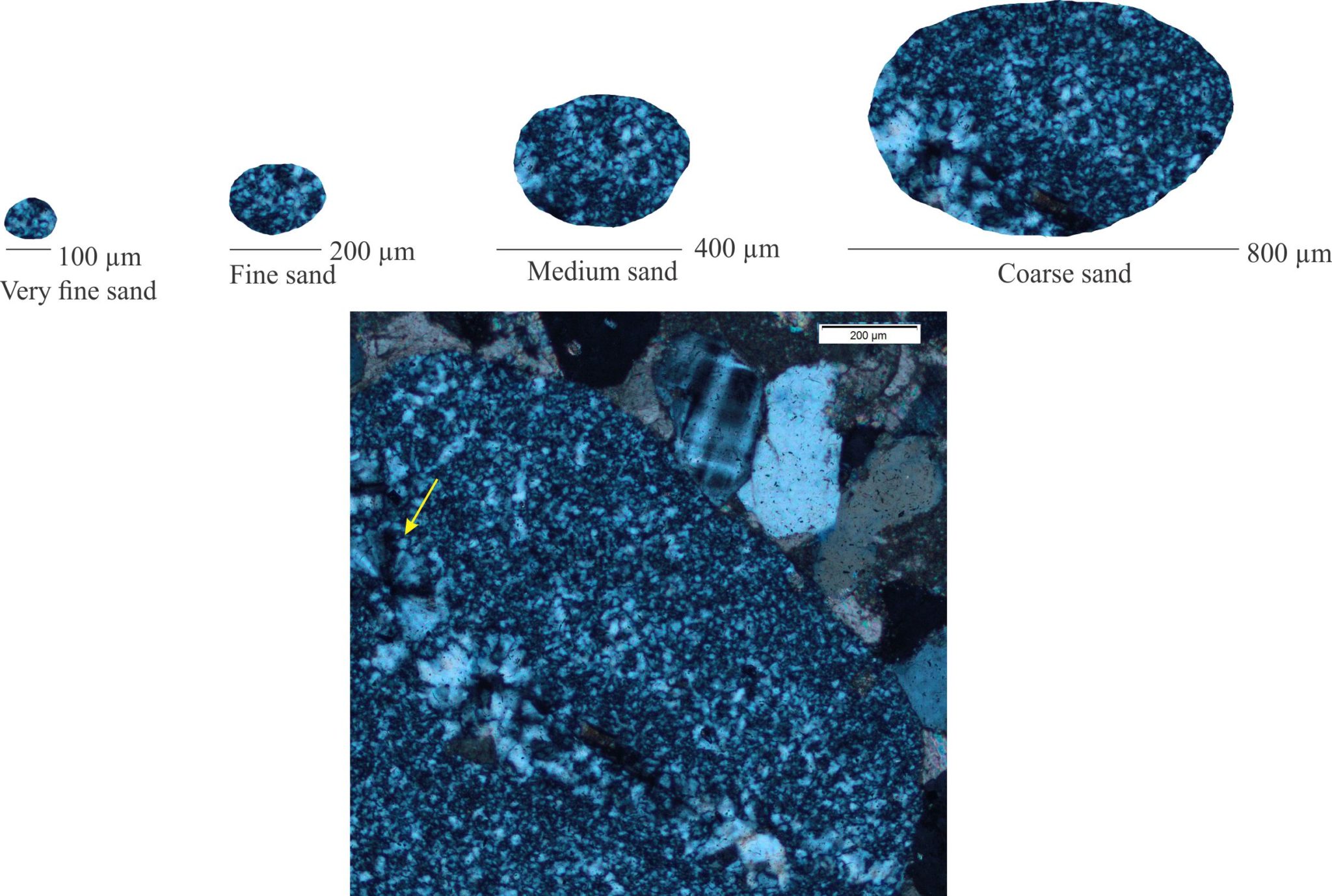
This example looks at the breakdown of an existing chert lithic clast. There is a diffuse band of partly recrystallized silica where the crystal size changes from <10 μm to about 100 μm (0.1 mm). Recrystallization has also produced some radial silica clusters (arrow).
- The micro-cryptocrystalline textures of typical chert lithic grains are relatively easy to distinguish from other quartz aggregates
- They are recognizable at grain sizes at least to fine sand.
- Grains consisting of the coarser recrystallized silica might pass for polycrystalline quartz grains unless radial crystal aggregates are also present.
- Incomplete recrystallization commonly produces patchy or clotted textures where patches of remnant microcrystals grade into coarser crystal aggregates, reminiscent of the structure grumeleuse in neomorphosed micrites.
Silty mudstone
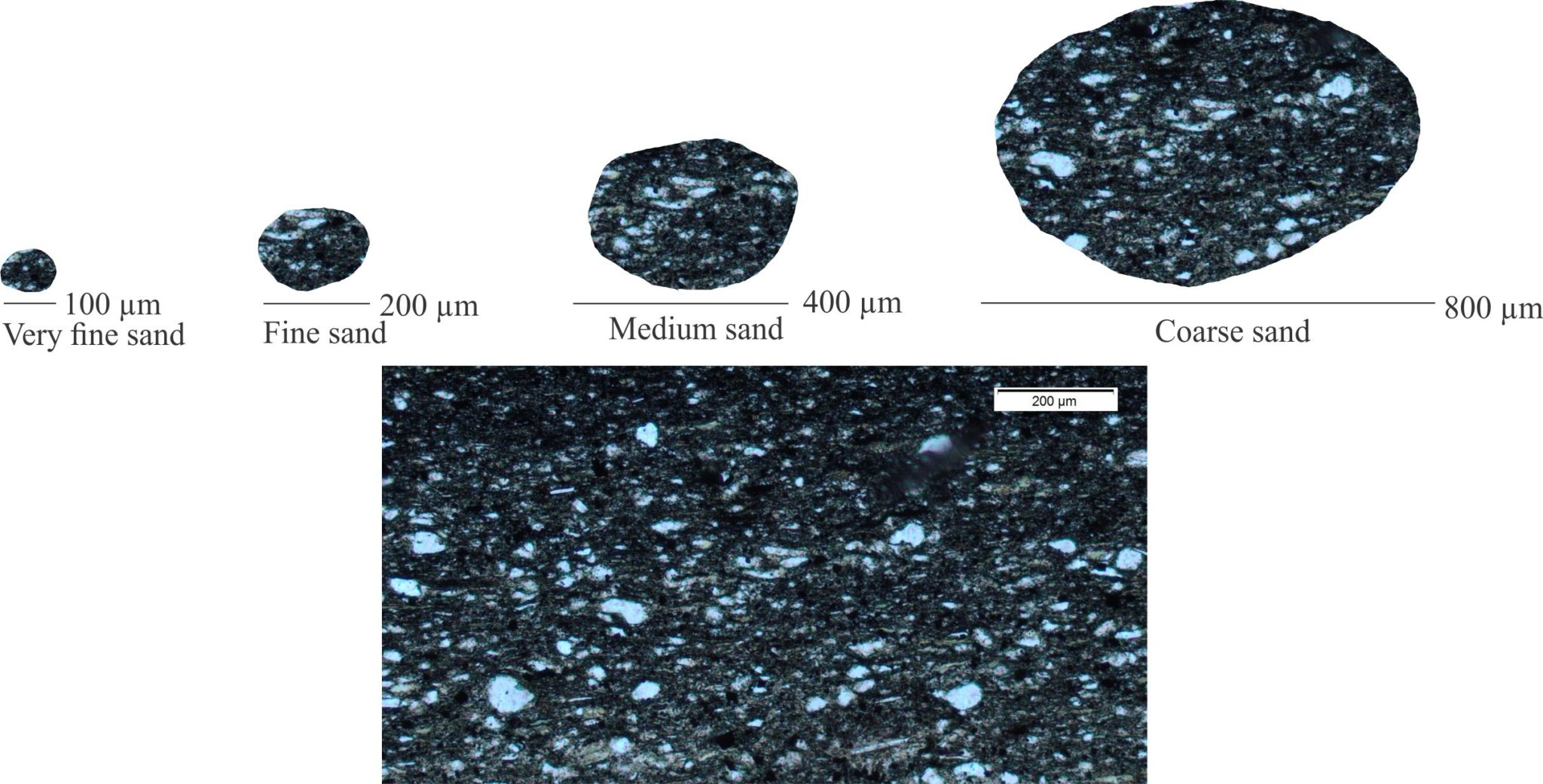
- There is a complete gradation from very fine framework clasts to matrix. This is recognizable in grains at least to medium sand size.
- Textures in some fine-grained sedimentary lithics may resemble the groundmass of aphanitic volcanic rocks, particularly if the feldspar laths have been diagenetically altered in the latter.
- Sedimentary layering in mudrock lithics must be distinguish from flow alignment of feldspars in aphanitic volcanic rocks.
Some generalizations
- The confidence with which clastic sediment source rocks can be identified depends strongly on the crystallinity or coarseness of potential sources. As a general rule, the coarser the crystallinity, the larger the clasts needed to positively identify that source.
- The above comment can be restated as – there is an optimum grain size where the whole-rock identity of a lithic fragment can be made. For example, the optimum clast size that captures the essential minerals and foliation for schist-type rocks will be smaller than that for coarser gneissic rocks. At progressively finer grain sizes the common rock-forming minerals (quartz, feldspar, various heavy minerals) tend to be presented as monomineralic grains rather than components of lithic grains.
- The specific source rock identity of common monomineralic, and even some polycrystalline aggregates of quartz and feldspar is frequently ambiguous, making the distinction among granite-granodiorite, gneiss, volcanic phenocrysts, or recrystallized chert difficulty. There are a few exceptions, such as bipyramidal quartz that is restricted to rhyolite, dacite, and ignimbrite, or minerals like kyanite and sillimanite that are found in high-grade metamorphic rocks.
- For provenance studies, choose the coarsest samples possible.
Other posts in this series
Optical mineralogy: Some terminology
The mineralogy of sandstones: porosity and permeability
The mineralogy of sandstones: Quartz grains
The mineralogy of sandstones: Feldspar grains
The mineralogy of sandstones: lithic fragments
The mineralogy of sandstones: matrix and cement
The provenance of detrital zircon
Provenance and plate tectonics
Carbonates in thin section: Forams and Sponges
Carbonates in thin section: Bryozoans

















